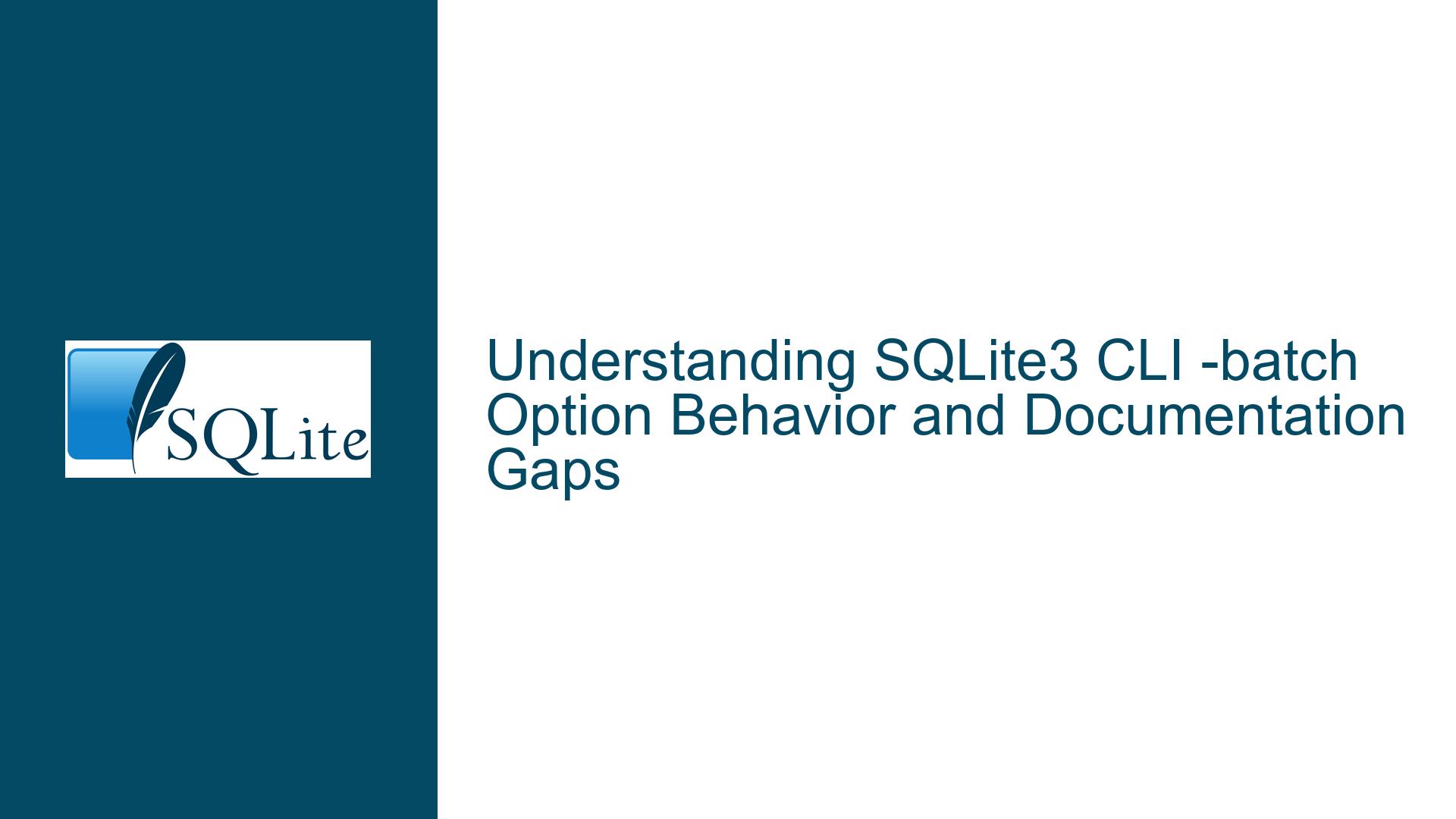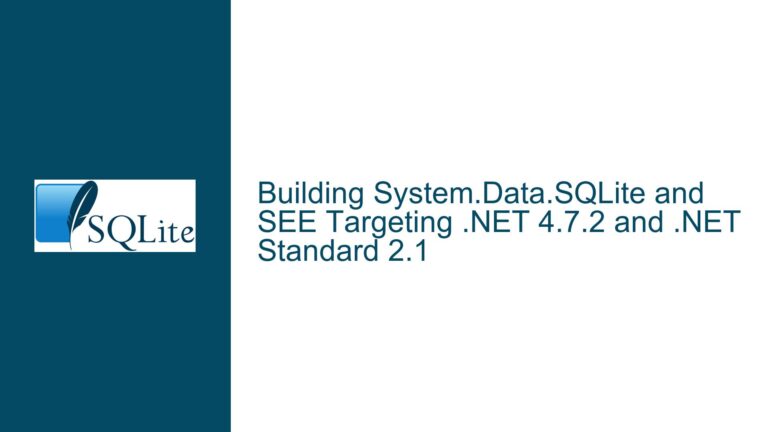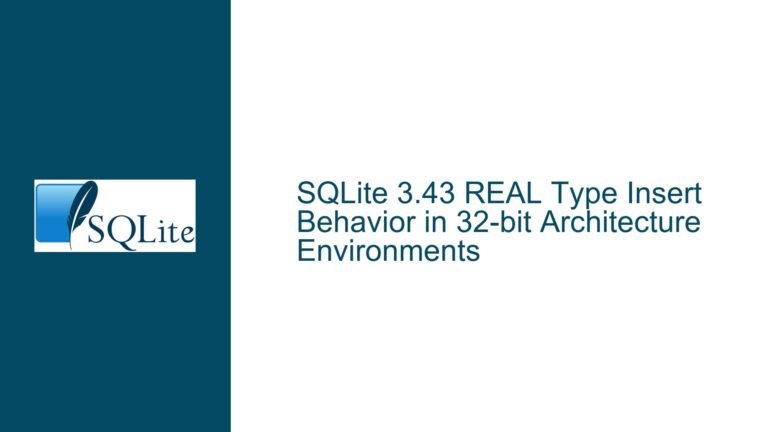SQLite3 CLI -batch Option Behavior and Documentation Gaps
Unclear Behavior of SQLite3 CLI -batch Option and Exit Code Handling
The -batch command-line option in the SQLite3 CLI (Command-Line Interface) has long been a source of confusion due to its sparse documentation and nuanced interaction with input/output (I/O) modes. The option is briefly described as "force batch I/O" in the CLI help text, but this phrase lacks specificity. Users have encountered scenarios where the CLI behaves unexpectedly in scripts, cron jobs, or automated workflows when -batch is used alongside other flags such as -cmd, or when input is redirected. Key issues include inconsistent exit code reporting, unexpected CLI termination behavior, and ambiguity around how -batch alters the shell’s interaction with standard input (stdin) and output (stdout).
For example, when running sqlite3 -batch -cmd 'select 1;', the CLI executes the SQL command but does not exit automatically, requiring manual intervention (e.g., sending .quit or an EOF signal). This contradicts user expectations for a "batch" mode that processes commands and exits without further input. Additionally, the interaction between -batch and error handling (via -bail) complicates script reliability, as exit codes may not reflect SQL errors unless specific conditions are met. The lack of clear documentation forces users to reverse-engineer behavior by examining the SQLite3 source code (e.g., shell.c), where variables like stdin_is_interactive and logic branches involving isatty(0) determine I/O modes.
Root Causes of Ambiguous -batch Functionality and Command Processing Issues
The ambiguity surrounding the -batch option stems from its role in toggling the CLI between interactive and non-interactive (batch) modes, a distinction that affects multiple subsystems within the shell. The primary factors contributing to this ambiguity are:
Input Source Detection Logic:
The CLI determines whether it is in interactive mode by checking if stdin is a terminal (usingisatty(0)). When input is redirected (e.g.,sqlite3 < script.sql) or piped, the shell defaults to non-interactive mode. The-batchflag overrides this detection, forcing non-interactive mode regardless of stdin’s source. However, this override does not fully disable all interactive behaviors, such as waiting for additional input after processing-cmdarguments. This creates a hybrid state where the CLI behaves partially like a batch processor but retains interactive traits.Exit Code Semantics:
In interactive mode, the CLI typically returns an exit code of0(success) even if SQL errors occur, as the shell assumes users will handle errors manually. In batch mode (enabled by-batchor input redirection), the CLI propagates SQL errors to the exit code, allowing scripts to detect failures. However, edge cases exist: if the CLI processes commands successfully but encounters an EOF (End-of-File) on stdin, it may still return0unless-bailis used to force termination on the first error. This inconsistency arises from the shell’s layered error-handling logic, where some errors are considered recoverable in interactive contexts but fatal in batch mode.Command Sequencing and Input Buffering:
Commands provided via-cmdare executed before the CLI enters its main input-processing loop. If these commands do not explicitly terminate the shell (e.g., with.quit), the CLI proceeds to read from stdin, even in batch mode. This leads to the "hanging" behavior observed when-cmd 'select 1;'is used without a subsequent.quitcommand. The CLI’s design prioritizes flexibility in command chaining but sacrifices predictability when users assume-batchimplies immediate exit after processing initial commands.Undocumented Interactions with -bail and -cmd:
The-bailoption, which aborts execution on the first SQL error, only takes effect in non-interactive mode. When combined with-batch, this ensures errors trigger non-zero exit codes. However, the CLI’s handling of.quitin-cmdsequences is inconsistent:.quitcommands may not terminate the shell if additional input is available, leading to unexpected blocking. This behavior is governed by internal flags inshell.cthat manage the shell’s state transitions, which are not transparent to users.
Resolving -batch Mode Quirks and Ensuring Proper CLI Termination
To address the challenges posed by the -batch option, users must adopt strategies that align with the CLI’s underlying logic while avoiding common pitfalls. The following solutions are organized by use case:
1. Forcing Immediate Exit After Command Execution
- Avoid
-cmdfor Termination: Instead of using-cmd '.quit', provide commands as bare arguments to the CLI. For example:sqlite3 -batch ':memory:' 'select 1;'This executes the command and exits immediately, as bare arguments bypass the interactive loop.
- Redirect stdin When Using
-cmd: If-cmdis necessary (e.g., for multiple pre-commands), redirect stdin to/dev/nullto prevent the CLI from waiting for input:sqlite3 -batch -cmd 'select 1;' ':memory:' < /dev/nullThis forces an EOF after processing
-cmdarguments, ensuring termination.
2. Reliable Error Handling and Exit Codes
- Combine
-batchwith-bail: To ensure the CLI exits with a non-zero code on SQL errors:sqlite3 -batch -bail ':memory:' 'select invalid_sql;'This guarantees termination on the first error and propagates the error code to the shell.
- Validate Exit Codes in Scripts: After executing the CLI, check
$?(in Bash) to handle errors:if ! sqlite3 -batch -bail 'db.sqlite' '.read script.sql'; then echo "SQL error detected. Exiting." exit 1 fi
3. Workaround for Pending Code Fixes
- Build from the
shell-tweaksBranch: As noted in the forum, a pending fix in SQLite’s development branch resolves.quitinconsistencies in-cmdsequences. Users requiring immediate relief can:- Clone the SQLite source repository:
git clone https://www.sqlite.org/src/sqlite.git - Check out the
shell-tweaksbranch and build the CLI:cd sqlite git checkout shell-tweaks ./configure && make sqlite3 - Use the custom-built
sqlite3binary until the fix is merged into a stable release.
- Clone the SQLite source repository:
4. Best Practices for Cron Jobs and Automation
- Use Bare Commands, Not
-cmd: Structure cron entries to avoid-cmd:0 */6 * * * /usr/bin/sqlite3 -batch '/path/to/db.sqlite' '.read script.sql' - Explicitly Redirect stdin: Ensure no lingering input can block termination:
(sleep 20; sqlite3 -batch ':memory:' '.read sweep.sql') < /dev/null - Leverage Temporary Databases: For ephemeral tasks, use
:memory:or temporary files to avoid locking persistent databases.
5. Understanding the Role of stdin_is_interactive
- Code Analysis: In
shell.c, thestdin_is_interactiveflag is set based onisatty(0)and the presence of-batch. This flag controls:- Prompt Display: Suppressed in batch mode.
- Input Buffering: Line-editing features (e.g., history) are disabled.
- Signal Handling: Interrupts (e.g., Ctrl+C) may abort the entire process instead of cancelling the current command.
- Implications for Developers: Custom builds of the CLI can modify
stdin_is_interactivelogic to prioritize batch behaviors, though this is not recommended without thorough testing.
By adhering to these guidelines, users can mitigate the ambiguities of -batch and achieve reliable, scriptable interactions with the SQLite3 CLI. Future updates to the shell are expected to simplify these workflows, but until then, a combination of command-line discipline and strategic input handling remains essential.






